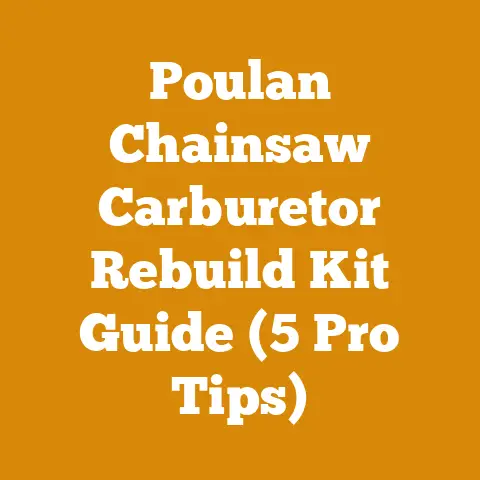031AV Stihl Chainsaw Buying Guide (5 Pro Tips for Used Tools)
Imagine this: a crisp autumn day, the scent of pine needles thick in the air, and the satisfying roar of a chainsaw echoing through the woods. You’re picturing yourself felling a tree, processing logs into manageable firewood, and feeling the primal satisfaction of providing warmth for your family. But before you can realize that vision, you need the right tool. And for many, the Stihl 031AV represents a sweet spot: a powerful, reliable, and often affordable option, especially on the used market.
Buying a used chainsaw, however, can be a gamble. You need to know what to look for to avoid ending up with a lemon. I’ve spent countless hours in the woods, felling trees, bucking logs, and prepping firewood, often relying on vintage Stihl chainsaws like the 031AV. Through trial and error, repairs and restorations, I’ve learned the ins and outs of these machines. This guide will share my pro tips for buying a used 031AV Stihl chainsaw, ensuring you get a solid tool that will serve you well for years to come.
031AV Stihl Chainsaw Buying Guide: 5 Pro Tips for Used Tools
The Stihl 031AV is a classic for a reason. It strikes a good balance between power, weight, and durability, making it suitable for a range of tasks, from felling smaller trees to limbing and bucking firewood. But a used chainsaw is only as good as its condition. Let’s dive into the key things to look for.
1. The Initial Inspection: Assessing Overall Condition
This is your first impression, and it’s crucial. Don’t just fire it up and assume everything’s fine. A thorough visual inspection can reveal a lot about how the chainsaw has been treated.
- Physical Appearance: Look for signs of excessive wear and tear. Scratches and scuffs are normal, but deep gouges, cracks in the plastic housing, or bent components are red flags. Pay close attention to the area around the handle and the chain brake lever. These areas are prone to damage.
- Bar and Chain: Examine the bar for wear. Is it straight? Are the rails worn unevenly? A worn bar can cause the chain to bind and cut inefficiently. Check the chain for sharpness, rust, and missing teeth. A dull or damaged chain is a safety hazard. I’ve seen chains that were so neglected they looked like they’d been dragged through gravel for miles. Replacing the bar and chain can add significant cost, so factor that into your offer.
- Fuel and Oil Leaks: Look for signs of fuel or oil leaks around the carburetor, fuel lines, and oil tank. Leaks indicate damaged seals or hoses, which will need to be replaced. A small fuel leak can quickly become a fire hazard, so don’t ignore it. I remember once working with a leaky saw on a hot summer day. The smell of gas was overwhelming, and I was constantly worried about a spark igniting it.
- Missing Parts: Check for any missing parts, such as the chain catcher, spark plug cover, or air filter cover. These small parts can be surprisingly expensive to replace.
- Case Study: I once inspected a 031AV that looked decent from afar. However, a closer look revealed a significant crack in the handle near the throttle trigger. This crack, likely caused by dropping the saw, made it unsafe to operate and would have required a complete handle replacement. I passed on that one.
2. The Engine Test: Starting, Idling, and Acceleration
A healthy engine is the heart of any chainsaw. This test will help you assess its condition.
- Starting: A healthy 031AV should start relatively easily, usually within a few pulls. If it takes excessive cranking, there may be issues with the carburetor, ignition system, or compression. Pay attention to the sound of the engine as it starts. A healthy engine will sound crisp and responsive. A weak or struggling engine may indicate problems.
- Idling: Once started, the engine should idle smoothly without stalling. If the engine idles roughly or stalls frequently, the carburetor may need adjustment or cleaning. It could also indicate a more serious problem, such as a vacuum leak. I’ve had to rebuild the carburetors on several older saws due to ethanol damage.
- Acceleration: Test the engine’s acceleration by quickly squeezing the throttle. The engine should respond immediately and smoothly without hesitation or sputtering. Hesitation or sputtering indicates a problem with the fuel delivery system or ignition system. If the chain doesn’t move when the throttle is engaged, the clutch may be worn.
- Smoke: Observe the color of the exhaust smoke. A small amount of white smoke is normal, especially when the engine is cold. However, excessive blue smoke indicates that the engine is burning oil, which could be a sign of worn piston rings or valve seals. Black smoke indicates a rich fuel mixture, which could be caused by a dirty air filter or a misadjusted carburetor.
- Compression Test (Advanced): If possible, perform a compression test using a compression tester. A healthy 031AV should have a compression reading of at least 120 PSI. Lower compression indicates worn piston rings or cylinder damage. This test requires a specific tool, but it’s the most reliable way to assess the engine’s internal condition.
- Personal Experience: I once bought a 031AV that started easily and idled smoothly but hesitated badly when I squeezed the throttle. After cleaning the carburetor and replacing the fuel filter, it ran like new. A simple fix saved me from a potentially expensive repair.
3. The Safety Features: Chain Brake and Throttle Lock
Safety features are non-negotiable. A malfunctioning chain brake or throttle lock can lead to serious injury.
- Chain Brake: The chain brake is designed to stop the chain immediately in the event of kickback. Test the chain brake by engaging it and then trying to rotate the chain by hand. The chain should not move. Disengage the chain brake and ensure that the chain spins freely. A properly functioning chain brake is essential for safety. I’ve personally experienced kickback on several occasions, and the chain brake has saved me from serious injury.
- Throttle Lock: The throttle lock prevents accidental acceleration. It should require deliberate pressure to engage the throttle. If the throttle lock is loose or doesn’t function properly, it could lead to accidental acceleration, which is extremely dangerous.
- Anti-Vibration System: The 031AV features an anti-vibration system to reduce operator fatigue. Check the rubber mounts that connect the engine and handle. If these mounts are worn or damaged, the saw will vibrate excessively, leading to discomfort and potential injury.
- Case Study: I once inspected a 031AV where the chain brake was completely seized. The owner had never maintained it, and it was rusted solid. I was able to free it up with some penetrating oil and careful manipulation, but it highlighted the importance of checking and maintaining safety features.
4. The Maintenance History: Asking the Right Questions
Understanding the chainsaw’s maintenance history can provide valuable insights into its overall condition and potential longevity.
- Ask about maintenance: Ask the seller about the chainsaw’s maintenance history. Has it been regularly serviced? When was the last time the carburetor was cleaned or adjusted? Has the fuel filter or air filter been replaced recently? Knowing the maintenance history can help you identify potential problems and avoid surprises.
- Fuel Mix: Inquire about the type of fuel mix used. Using the correct fuel-to-oil ratio is crucial for engine longevity. The 031AV typically requires a 50:1 fuel-to-oil ratio. Using the wrong fuel mix can lead to engine damage.
- Oil Type: Ask about the type of bar and chain oil used. Using a high-quality bar and chain oil is essential for lubricating the chain and preventing wear on the bar.
- Storage: Find out how the chainsaw was stored. Storing a chainsaw properly is important for preventing damage and extending its lifespan. The chainsaw should be stored in a dry place, away from direct sunlight and extreme temperatures. The fuel tank should be emptied before storing the chainsaw for an extended period.
- Documentation: If possible, ask for any documentation, such as service records or original manuals. This documentation can provide valuable information about the chainsaw’s history and maintenance.
- My Tip: Don’t be afraid to ask questions. The seller’s willingness to answer your questions and provide information can be a good indicator of their honesty and the chainsaw’s condition. If the seller is evasive or unwilling to provide information, it’s a red flag.
5. The Price Negotiation: Determining Fair Value
Determining the fair value of a used 031AV Stihl chainsaw can be tricky, as prices vary depending on condition, location, and availability. However, here are some factors to consider:
- Condition: The most important factor is the chainsaw’s condition. A chainsaw in excellent condition with low hours will be worth more than a chainsaw in poor condition with high hours.
- Age: The age of the chainsaw can also affect its value. Older chainsaws may be less desirable than newer models, even if they are in good condition. The 031AV was produced from the late 1970s to the early 1990s, so all models are considered vintage.
- Availability: The availability of used 031AV chainsaws can also affect their price. If there are few available, the price may be higher.
- Location: Prices can vary depending on location. Chainsaws may be more expensive in areas where they are in high demand.
- Research: Research the prices of similar used 031AV chainsaws online. Check online marketplaces, such as eBay, Craigslist, and Facebook Marketplace, to get an idea of the current market value.
- Negotiation: Don’t be afraid to negotiate the price. Point out any flaws or issues you find during your inspection. Be prepared to walk away if the seller is unwilling to negotiate a fair price.
- Replacement Costs: Factor in the cost of potential repairs or replacement parts. Even if the chainsaw appears to be in good condition, there may be hidden problems that will require additional investment.
- My Experience: I once negotiated the price of a used 031AV down by $50 because I noticed a small crack in the fuel tank. The seller was initially unwilling to budge on the price, but I pointed out that the crack would eventually need to be repaired, which would cost him money. He eventually agreed to lower the price.
- Rule of Thumb: A well-maintained 031AV in good working condition typically sells for between $150 and $300, depending on the factors mentioned above. Be wary of deals that seem too good to be true, as they may indicate hidden problems.
Additional Considerations for the Global Buyer
For those buying a used 031AV Stihl chainsaw from outside their local market or even internationally, there are additional factors to keep in mind:
- Shipping Costs: Shipping a chainsaw can be expensive, especially if it’s coming from overseas. Factor in the cost of shipping when determining the overall value of the chainsaw.
- Customs and Import Duties: Be aware of any customs duties or import taxes that may apply when importing a chainsaw. These fees can add significantly to the overall cost.
- Voltage and Frequency: If you’re buying a chainsaw from a country with a different voltage or frequency, you may need to use a voltage converter or frequency adapter to operate it safely. This is less of a concern for the 031AV, which is gasoline-powered, but it’s important to consider for any electric tools you may be using.
- Language Barriers: If you’re buying a chainsaw from a seller who speaks a different language, communication can be challenging. Use online translation tools or enlist the help of a translator to ensure that you understand the terms of the sale and the condition of the chainsaw.
- Payment Methods: Use a secure payment method, such as PayPal or a credit card, to protect yourself from fraud. Avoid sending cash or using unsecured payment methods.
- Return Policy: Check the seller’s return policy before making a purchase. Make sure you understand the terms of the return policy and what recourse you have if the chainsaw is not as described.
- Example: I once considered buying a used 031AV from a seller in Germany. The price was attractive, but the shipping costs and import duties would have added significantly to the overall cost. I also had concerns about the language barrier and the seller’s return policy. In the end, I decided to purchase a chainsaw locally to avoid these potential complications.
Safety First: Essential PPE and Best Practices
Regardless of whether you’re buying a new or used chainsaw, safety should always be your top priority. Here’s a reminder of essential personal protective equipment (PPE) and best practices:
- Personal Protective Equipment (PPE):
- Chainsaw Helmet: Protects your head from falling branches and kickback.
- Hearing Protection: Chainsaws are loud and can cause hearing damage over time.
- Eye Protection: Safety glasses or a face shield protect your eyes from flying debris.
- Chainsaw Gloves: Provide a good grip and protect your hands from cuts and vibrations.
- Chainsaw Chaps or Pants: Offer crucial protection for your legs in case of accidental contact with the chain.
- Steel-Toed Boots: Protect your feet from falling logs and other hazards.
- Best Practices:
- Read the Manual: Familiarize yourself with the chainsaw’s operating instructions and safety features.
- Maintain Your Chainsaw: Keep your chainsaw in good working condition by regularly sharpening the chain, cleaning the air filter, and checking the fuel and oil levels.
- Use the Right Fuel Mix: Use the correct fuel-to-oil ratio recommended by the manufacturer.
- Work in a Safe Area: Clear the area around you of obstacles and ensure that you have a clear escape route.
- Use Proper Cutting Techniques: Learn and practice proper cutting techniques to avoid kickback and other hazards.
- Never Cut Above Your Head: Cutting above your head is extremely dangerous and should be avoided.
- Take Breaks: Chainsawing can be physically demanding. Take regular breaks to avoid fatigue and maintain focus.
- Never Work Alone: Always work with a partner in case of an emergency.
- First Aid Kit: Keep a well-stocked first aid kit nearby in case of injury.
- Personal Anecdote: I once witnessed a serious chainsaw accident where a worker was not wearing chainsaw chaps. He suffered a severe leg injury that required extensive surgery. This incident reinforced the importance of wearing appropriate PPE at all times.
Beyond the Purchase: Maintaining Your 031AV
Once you’ve found a good used 031AV, proper maintenance is key to keeping it running smoothly for years to come. Here are some essential maintenance tasks:
- Chain Sharpening: A sharp chain is essential for efficient cutting and safety. Learn how to sharpen your chain properly using a file or a chainsaw sharpener.
- Air Filter Cleaning: A clean air filter allows the engine to breathe properly. Clean the air filter regularly using compressed air or a brush.
- Spark Plug Replacement: Replace the spark plug periodically to ensure reliable ignition.
- Carburetor Adjustment: Adjust the carburetor as needed to maintain proper fuel mixture.
- Fuel Filter Replacement: Replace the fuel filter regularly to prevent fuel contamination.
- Bar and Chain Oil Level: Check the bar and chain oil level frequently and refill as needed.
- Chain Tension: Maintain proper chain tension to prevent the chain from derailing or binding.
- Cleaning: Keep the chainsaw clean by removing sawdust and debris after each use.
- Storage: Store the chainsaw properly in a dry place, away from direct sunlight and extreme temperatures.
- Resource: The Stihl website offers valuable resources, including owner’s manuals and maintenance tips. You can also find helpful tutorials on YouTube and other online platforms.
Conclusion: The Legacy of the 031AV and Your Next Steps
The Stihl 031AV is more than just a chainsaw; it’s a testament to robust engineering and enduring design. By following these pro tips, you can confidently navigate the used market, find a reliable tool, and enjoy the satisfaction of working with a classic.
Now that you’re armed with this knowledge, here are your next steps:
- Start Your Search: Begin browsing online marketplaces and local classifieds for used 031AV chainsaws.
- Contact Sellers: Reach out to sellers and ask questions about the chainsaw’s condition and maintenance history.
- Schedule an Inspection: Arrange to inspect the chainsaw in person.
- Perform the Tests: Conduct the engine test, safety feature test, and visual inspection.
- Negotiate the Price: Negotiate a fair price based on the chainsaw’s condition and market value.
- Purchase and Maintain: Purchase the chainsaw and begin performing regular maintenance to keep it running smoothly.
- Get to Work (Safely!): Enjoy the satisfaction of using your 031AV to tackle your wood processing and firewood preparation projects.
Remember, buying a used chainsaw requires patience, diligence, and a keen eye for detail. But with the right knowledge and a little bit of luck, you can find a Stihl 031AV that will serve you well for many years to come. Happy cutting!






